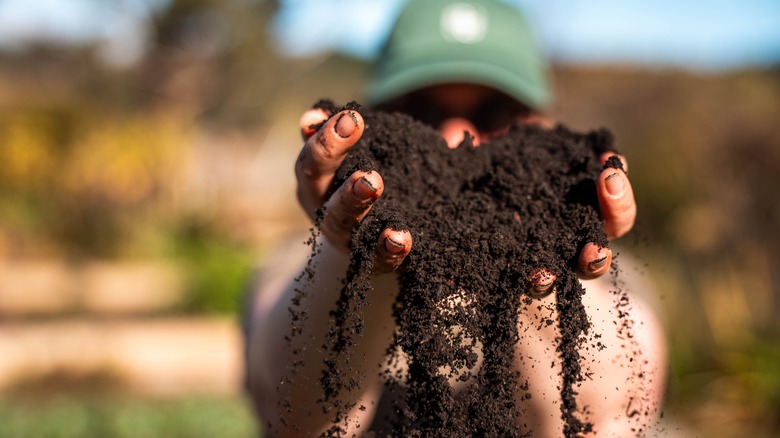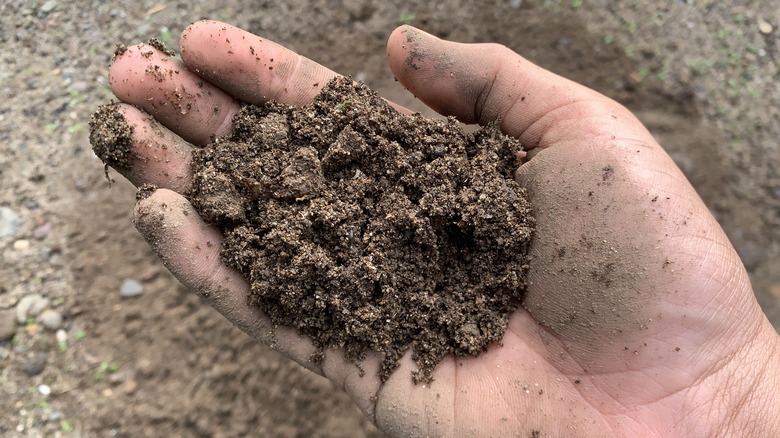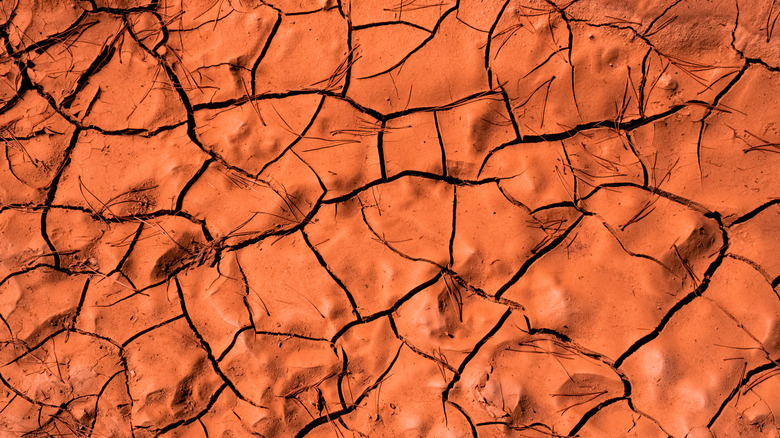What Your Garden's Soil Color Really Means And Why It Matters
We can all imagine what healthy soil looks like: Rich, crumbly, and dark brown, bursting with nutrients and ready to house your greenest veggies, most succulent fruits, and prettiest flowers. But sometimes we're not all so lucky as to have homes or gardens that come ready-made with beautiful, fertile soil. Maybe your yard's soil is a little on the redder side, meaning it's clay-rich; maybe it's a greenish gray, suggesting you may have a drainage problem; or maybe it's a light brown or tan, which could mean it's low in nutrients and doesn't retain water well.
It's important to understand what is in your topsoil (and why your garden cares), and the color of the soil can help you determine that. Wherever you live and no matter what you're trying to grow, taking note of your soil color is helpful — getting better results in your garden could be a simple fix, or you may have to spend some time and money getting the soil just right. Let's break down three common soil colors, what they mean, and how to work with them.
Light brown or white soil
When you're faced with a lighter shade of brown in your soil, it could indicate that many of the nutrients necessary for healthy soil — like iron and phosphorus — are missing. Light brown soil can be corrected by adding plenty of organic matter, mulch, and fertilizer. For example, alfalfa meal is one organic fertilizer that'll do wonders for your garden soil, as it contains a balance of nitrogen, phosphorus, and potassium. Once you add these components, you can move forward with planting your garden normally. But if you aren't able to add anything to your light brown soil, try planting species that need low amounts of water.
If the color of your soil is even lighter, closer to white, you may live in a dry or coastal area — this shade of soil means there's a high percentage of sand in the ground. When you're dealing with sandy soil, you'll have to combat the lack of humus, a crucial component of healthy soil comprised of decaying organic matter. Due to the lack of nutrients in sandy soil, you'll likely have to purchase topsoil from a garden store or use raised beds to successfully grow your plants.
Red soil or gray soil
While red soil is striking in appearance, it can be tricky to work with when gardening. Soil usually gets its red hue from the presence of iron oxide, which we know more colloquially as rust. You'll often find this type of soil in more humid, rainy, and hot climates. Red can also indicate higher amounts of clay, which tends to hold onto more moisture than less clay-rich soil. This can dictate which plants will grow best in these gardens.
Red soil of a darker or orange color can be a sign that the soil isn't draining well, while bright red soil is the most ideal — well-draining and richer in nutrients. Key nutrients like calcium may still be missing, however, and need to be added. Consider using plants that thrive in iron-rich environments, like rhododendron (Ericaceae). Or look for plants that thrive in clay soil, such as lettuce, green beans, common elderberry shrubs (Sambucus canadensis), and black chokeberry (Aronia melanocarpa).
Gray-colored soil can be chalked up to a variety of causes, from the presence of elevated amounts of organic matter to aluminum and clay minerals. Gray soil often retains water well and is nutrient-rich, needing little fertilizer. However, it can become waterlogged, and plants that do better in drier conditions aren't ideal for gray-soil areas. Gray soil can also indicate the presence of anaerobic bacteria, which form when the aerobic bacteria are quite literally drowned by waterlogged soil. They take in a lot of iron, leeching the color from the soil. If your gray soil is retaining water a little too well, try amending the soil with compost and peat moss.


